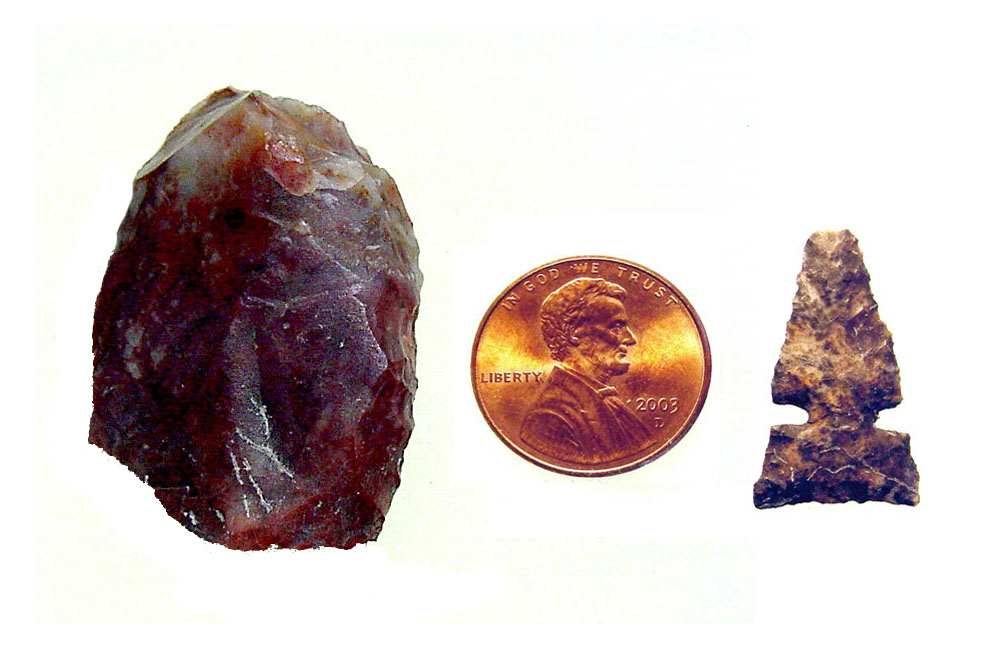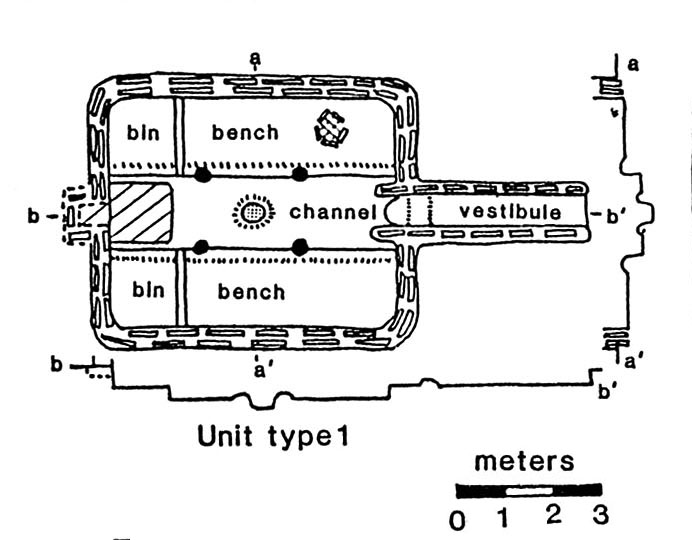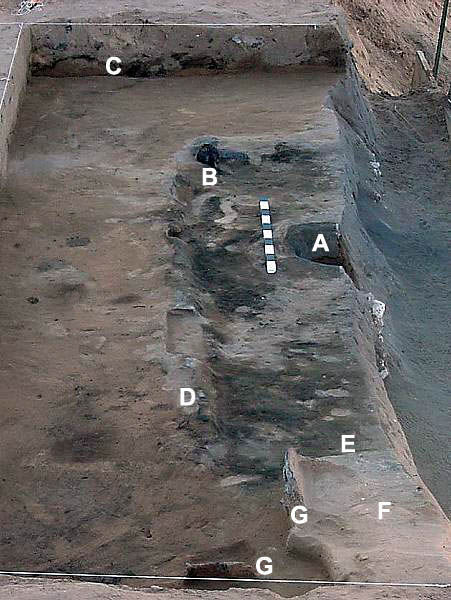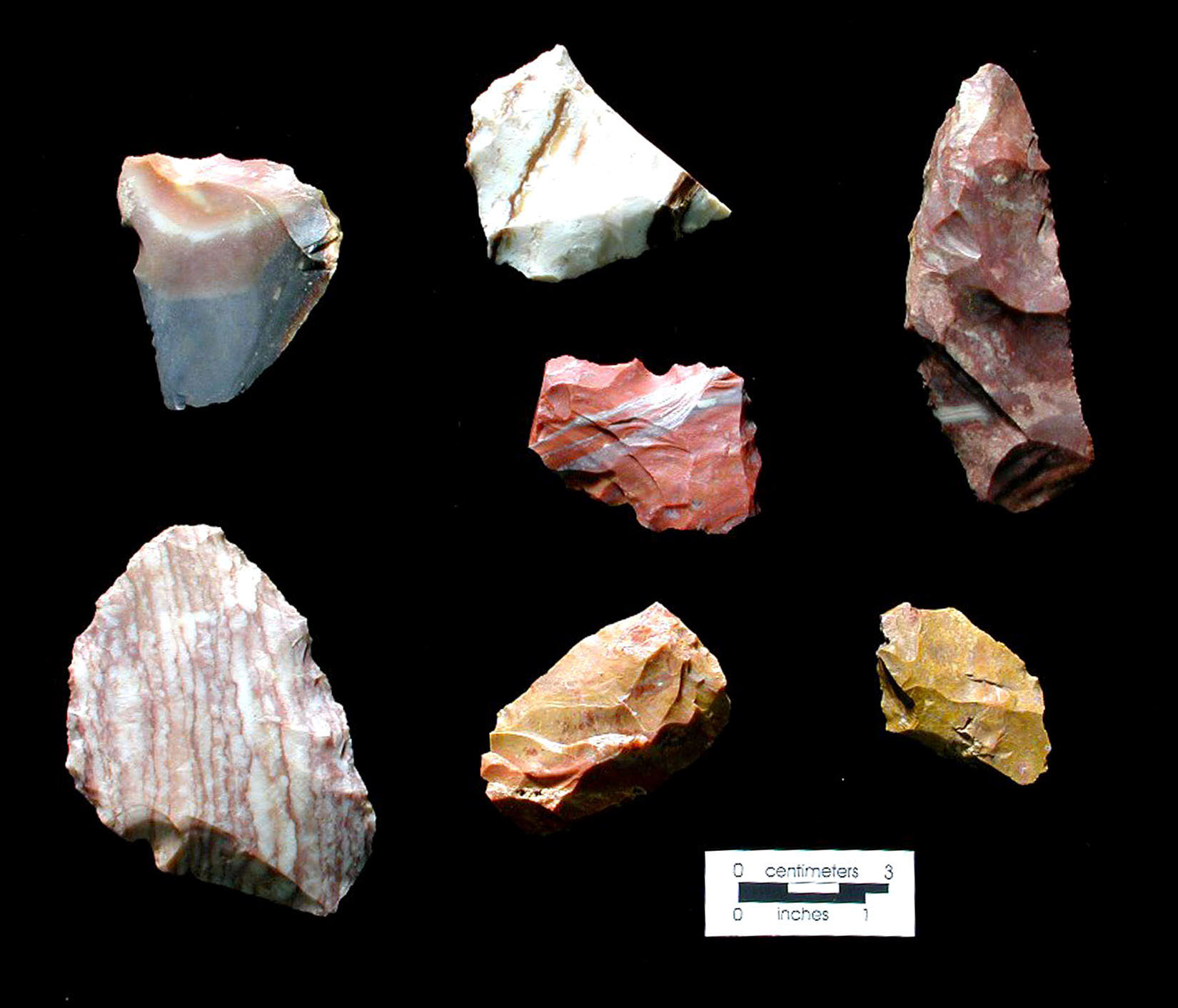
Object: Washita arrow point and scraper made of Alibates agatized dolomite
Date: cal A.D. 1276-1391, Plains Village period
Context: Southern High Plains, Canadian River Breaks, Hank's House
Alibates flint is a distinctive multicolored stone from the Texas Panhandle coveted for making chipped-stone tools. Alibates "flint" (technically, agatized dolomite) was traded widely in prehistory—as far as Montana and Central Mexico. Here we highlight two tools made of Alibates flint, a Washita arrow point and a scraper, found at a Plains Villager site in the Texas Panhandle. Plains Villagers were semi-sedentary corn farmers who lived much of the year in pithouse villages, but who also foraged wild plants and traveled to hunt bison. Numerous Plains Village groups settled in the greater Panhandle area in the thirteenth and fourteenth centuries. Though Plains Village groups shared similar economies, archaeologists have identified considerable variation between groups, as evidenced by distinct material culture, including differences in pithouse architecture. An enigmatic pithouse excavated at Hank's site, where these artifacts were found, challenges archaeologists' understanding of Plains Village groups.
Hank's House was at risk of imminent destruction when it was identified by amateur archaeologist John R. Erickson, author of the Hank the Cowdog books and owner of the ranch where the site is located. A flood prone arroyo had washed away half of the buried structure when Erickson identified it in the cut bank. Soon after, Hank's House was excavated by a volunteer crew of Panhandle archaeologists. The site excavation is discussed in the TBH exhibit Hank's House 1:Anatomy of a Burned Pithouse. In the companion TBH piece Hank's House 2: A Puzzle Wrapped in a Mystery Erickson discusses how the site fits into the big picture of Plains Villager archaeology. Here, we focus on two Alibates flint artifacts, a Washita arrow point and a hide scraper. Humble as they might seem, their stories are intertwined with those of life at Hank's House, the ultimate destruction of the pithouse by fire, and Plains Villager life more generally.

Excavations revealed a rectangular pithouse (Hank's House) with a footprint almost exactly like that of the most common pithouse type in the Texas Panhandle, known as an Antelope Creek Type 1 pithouse. (Antelope Creek is the Plains Villager pattern most characteristic of the Texas Panhandle, as discussed on TBH's Antelope Creek Defined. Because Hank's House had burned, many organic architectural components, such as support posts and roof thatching, were amazingly well preserved, allowing for an unusually good understanding of the pithouse construction, especially the wall and roof architecture. Though Hank's House fits the model of an ordinary Antelope Creek Type 1 pithouse in most ways, its walls lacked an interior lining of stone slabs. Instead, the walls were lined with vertical wooden picket-posts.
The Hank's House researchers believe this seemingly anomalous variation in architecture might represent a transitional style that could augment our understanding of the movement or influence of different culture groups through the Panhandle region. In addition, the excavation revealed that Hank's house had a substantial roof made of a wooden timber frame topped with layers of branches, grass, and earth. The evidence shows that Hanks' House was a true earth lodge, similar to the prehistoric earth lodges found in the central and northern Great Plains.

The Alibates flint outcrops are at the geographic heart of the Antelope Creek cultural area. While Hank's site falls within the “Greater” Antelope Creek area, the outcroppings of Alibates flint are approximately 60 miles southwest of Hank's site. Today, the flint outcrops are managed by the National Park Service at Alibates Flint Quarries National Monument. Though outcrops of Alibates are localized, cobbles of the material have been found along the Canadian River and downstream of its junction with the Arkansas River, meaning that the raw material can be obtained outside the core region.
Alibates flint is difficult to shape compared to some other tool stone, suggesting it was coveted for aesthetic reasons rather than for knap-ability. It is banded or variegated and occurs in a range of colors, including white, reds, purples, yellow-oranges, and blueish hues. It has been used for stone tool manufacture since the Clovis period (ca. 13,000 years ago), however, the Hank's House artifacts were made much more recently; calibrated radiocarbon assays of charred timbers excavated from Hank's House yielded dates between A.D. 1276 and 1391 (Late Prehistoric period). This date range is consistent with dates for many other Plains Village sites where Washita arrowpoints are found.
Both artifacts were found near the back wall of the buried, collapsed pithouse, opposite the east-facing entryway. The scraper was discolored and fractured from the intense heat of the fire, but the effects of burning are even more noticeable on the Washita arrow point—the characteristic colorfulness of the Alibates flint is no longer apparent.

The Washita arrow point type is distinguished from other triangular arrow points from the Southern Great Plains by its side notches and unnotched base. Washita points are common across western Oklahoma and the Texas Panhandle, and they are found in surrounding areas as well. The tip of the Hank's House point was broken off, likely the result of a missed shot. Hank's House archaeologists surmise that the hunter brought the arrow back to the house to be repaired (sharpened), and the broken arrowhead was then discarded or lost in the house. The scraper was also broken and perhaps similarly discarded or lost. Arrow points and scrapers were used to hunt bison and process their hides, respectively, and are common but important artifacts of Plains Villager life.
Few other artifacts were found in the excavated ruins of the house: some flakes of Alibates flint, small turtle bones, and cordmarked pottery sherds. The scarcity of artifacts indicates that the house was likely cleaned out and abandoned before it burned; the presence of many artifacts found inside the house, would indicate that the house caught fire while people were living in it, either by accident or arson. Though many questions linger around Hank's House, the working hypothesis is that the house was burned after its useful life span (estimated at 10-20 years), because its derelict ruin would present a hazard to the village and an invitation to snakes and other varmints. Other burned Plains Villagers houses have been found and research into the intentional burning of this style of earth lodge is ongoing on Erickson's ranch. While Hank's House is the first excavated pithouse in the Texas Panhandle to be formally called an earth lodge, a subsequent excavation at Drover's House (yes, its named for Hank the Cowdog's sidekick) has produced even stronger archeological evidence for earth lodges in the region.
These Alibates artifacts from Hank's House are noteworthy not because they are unusual, but rather because they are emblematic of bison hunting Plains Villagers inhabiting the Texas Panhandle 700 years ago. However, their archaeological context—found on the floor of a burned earth lodge—situates the artifacts in a story that is quite extraordinary.
Credits
Adapted from the Hank's House TBH exhibits and the TBH Alibates exhibit by TBH Editorial Assistant Emily McCuistion, with help from Doug Boyd. The archeological investigations at Hank´s and Drover´s Houses were undertaken as part of the West Pasture Archeological Project on John Erickson´s M-Cross Ranch in Roberts County, Texas. Boyd is a collaborator with Plains Archeological Research, a 501(c)(3) nonprofit group based in Perryton, Texas. Today (2020) PAR is continuing the West Pasture archeological research and education efforts with the support of the Payne Foundation of Pampa, Texas..
Print Sources
Boyd, Douglas K.
2008 Prehistoric Agriculture on the Canadian River of the Texas Panhandle: New Insights from West Pasture Sites on the M-Cross Ranch. Plains Anthropologist 53(205):33-57.
Boyd, Douglas K. and L. Douglas Wilkens
2001 Burnin' Down the House: Late Prehistoric Architecture, Abandonment, and Agriculture at Hank's Site, 41RB109, Roberts County, Texas. Current Archaeology in Texas 3(2):1-8.
Jelks, Edward B.
1993 Observations on the Distributions of Certain Arrow-Point Types in Texas and Adjoining Regions. Lithic Technology 18(1-2):9-15.
Lintz, Christopher B
1986 Architecture and Community Variability within the Antelope Creek Phase of the Texas Panhandle. Studies in Oklahoma's Past No. 14. Oklahoma Archeological Survey, Norman.